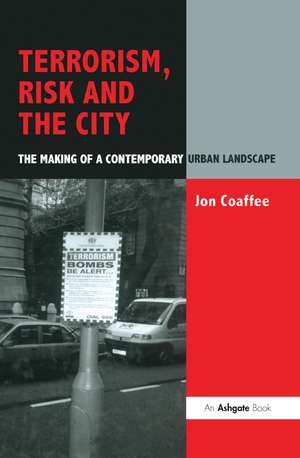Terrorism, Risk and the City: The Making of a Contemporary Urban Landscape
Autor Jon Coaffeeen Limba Engleză Hardback – 28 noi 2003
Preț: 764.20 lei
Preț vechi: 1102.79 lei
-31% Nou
Puncte Express: 1146
Preț estimativ în valută:
146.23€ • 159.34$ • 123.22£
146.23€ • 159.34$ • 123.22£
Comandă specială
Livrare economică 02-16 aprilie
Doresc să fiu notificat când acest titlu va fi disponibil:
Se trimite...
Preluare comenzi: 021 569.72.76
Specificații
ISBN-13: 9780754635550
ISBN-10: 0754635554
Pagini: 282
Ilustrații: bibliog , index
Dimensiuni: 153 x 219 x 21 mm
Greutate: 0.45 kg
Ediția:New ed
Editura: Taylor & Francis
Colecția Routledge
Locul publicării:Oxford, United Kingdom
ISBN-10: 0754635554
Pagini: 282
Ilustrații: bibliog , index
Dimensiuni: 153 x 219 x 21 mm
Greutate: 0.45 kg
Ediția:New ed
Editura: Taylor & Francis
Colecția Routledge
Locul publicării:Oxford, United Kingdom
Cuprins
Contents: Part I: Transforming Cities in the Age of Terrorism: Introduction: terrorism, risk and the City; Urban restructuring and the development of defensive landscapes; Controlling the security discourse in the postmodern City; Risk society and the global terrorist threat. Part II: The City of London's Response: Constructing and reinforcing the ring of steel; Distributing the financial risk of terrorism; Framing, legitimating and negotiating the City's response to terrorist risk. Part III: Terrorism, Risk and the Future City: Beating the bombers: a decade of counter terrorism in the City of London; Terrorism and future urbanism; Bibliography; Index.
Notă biografică
Jon Coaffee, Chair of Spatial Planning, Centre for Urban and Regional Studies, Birmingham Business School, University of Birmingham, UK
Recenzii
’Global terrorism has moved cities into the front-line of a battle with no boundaries and no visible enemies. This carefully researched book, with its focus on the activities of the Provisional IRA in London, provides valuable insight into the threat posed by terrorists and the responses available to the state. It is essential reading for anyone interested in the future of the world’s major cities.’ John R. Gold, Oxford Brookes University, UK ’...essential reading for anyone seeking [to] grapple with the place of cities within today's never-ending states of emergency.’ Professor Stephen Graham, Newcastle University, UK ’There can be few security professionals who do not have the threat of terrorism on their list of risk factors. This book is therefore recommended without hesitation to anyone who has an interest in learning more about the impact of terrorism on the urban environment...you should take the time to read this book.’ Professional Security ’Innovative, interesting, indispensable  invest in a copy!’ Habitat ’...the work of Coaffee is most appreciated. The book gives a rich insight into many aspects of the London case...the book of Coaffee is rational in its analysis...’ disP ’This is an innovative book...brings together issues for those studying the built environment who may not have had cause nor reason in the past to study security related issues. This book would be just as relevant to a student in sociology, planning or modern history - such [are] the wide-ranging issues that it addresses...a well-written and researched book...anyone involved in urban planning, land use, design or management should purchase this book.’ CEBE Projects and Initiatives ’...excellent...the author’s examination of the London Corporation’s role in developing the Ring of Steel through the brokering of deals between Government and the insurance industry is a stark and timely example of risk society and its consequences.’ Journal of Cont
Descriere
The development of defensive strategies encompassing the fortification and privatisation of the city has attracted significant attention during recent years and has become particularly relevant in the aftermath of September 11th. Dealing with issues of risk, security and the spatial restructuring of contemporary Western cities, this book examines how the perceived risk of terrorist attack led to changes in the physical form and institutional infrastructure of the City of London during the 1990s when the City was a prime terrorist target.
